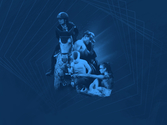UIPM Para Sports Spotlight: All your Para Obstacle questions answered

In September, the rebranded World Obstacle / UIPM 2023 OCR World Championships will recognise the union of two sporting movements. And the celebration will not be exclusive to able-bodied athletes.
There will also be a Para OCR World Championships as part of the inclusive athlete gathering in Genk (BEL), underlining the potential of Obstacle Racing to enhance the UIPM Sports movement now that Obstacle Discipline has been formally integrated into Modern Pentathlon at under-age levels.
World Obstacle has an established para athlete scene, driven by a pioneering spirit embodied by John de Haan, an experienced amputee athlete who chairs the para movement. In this Q&A, John provides information for aspiring Para Obstacle / Para Pentathlon athletes and highlights the benefits of the ongoing cooperation.
Who can participate in the Para OCR World Championships?
Adaptive athletes with a disability in the race categories PO1 to PO5 can compete in the para competition waves. Having this category structure doesn't mean that we always have award and competition waves for each category. Depending on the numbers of participants, we can combine categories to enable more athletes to compete.
Does the athlete need to become a member of Obstacle NF?
You need to be a member of your Obstacle Sports National Federation to compete in the OCR World Championships. Also you need to check the qualification criteria of your country, because it differs by country. So does the qualification procedure which determines how NFs select athletes to compete in the OCR World Championships.
How can athletes get classified for OCR competitions?
They must fill in a medical form and send it to myself at John.dehaan@worldobstacle.org. The World Obstacle Medical Commission will review the application and send it back to the athlete with the correct category on it. If they need more information they will reach out to athletes.
To what extent does the UIPM Obstacle Catalogue support the training needs of a Para team?
To learn the basic techniques, it's okay to train on those obstacles. In the races you will be facing a lot bigger and more technical obstacles, so be prepared for that. But a lot of them can be overcome with the basic technical skills.
What training tips would you like to share?
- Make sure that you can make a good foot lock in a rope.
- Train every single muscle in your body, because you need them all during a race.
- Watch videos of obstacles and keep trying new techniques.
Is it currently possible to cater for wheelchair athletes?
Wheelchair is a tough category for the competition waves, because athletes are not able to complete the course on their own power. The best races for wheelchair athletes are the flat races, where the surface is normally no problem for them (sand, mud, forest).
Why should athletes compete in Para Obstacle Racing?
The reason they must compete is simple. Everyone wants to push his or herself to their limits.
Competing in an adaptive race makes it easier to push yourself hard to get a great result. Running for fun is always great, but it doesn't test your limits. You need that extra drive that competition provides, and the fact that Obstacle Sport is becoming part of Modern Pentathlon means it’s all good training and investment in your future programme within UIPM Sports.
What excites you about the future of the UIPM / World Obstacle collaboration?
The integration of Obstacle to the UIPM Sports programme is going to benefit so many athletes. Working together with UIPM is going to make it easier to combine the two sports and the two communities.
Every athlete benefits when organisations work together, as long they have the same goal. For now, World Obstacle and UIPM have the same goal, and that's to establish Obstacle as part of Modern Pentathlon and the Olympic Games, so we need to work together to make this happens.




